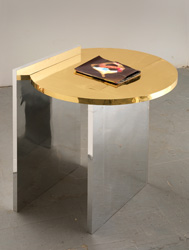Alice Koönitz, Magazine Table, 2008.
Born 1970 in Essen, Germany; lives in Los Angeles, California
Alice Könitz’s sculptures riff on midtwentieth- century modernist furniture and public art, while her installations of drawings, films, collages, and homemade magazines contextualize her monolithic geometric forms as both a celebration and a critique of design vernacular. Built from such inexpensive, readily available materials as construction paper, felt, lauan, cardboard, and plastic, and cobbled together with little more than a glue gun, Könitz’s sculptures offer a handmade intimacy absent in the high modernist forms they emulate. Rather they recall that mid-twentieth-century utopian vision of design’s ability to facilitate social change on an individual level. Like the diverse work of Charles and Ray Eames, Könitz’s practice erases boundaries between art and design, though her nonfunctional constructions operate more clearly as models illustrating how modernist design tenets have become clichéd in their translation to the tacky signs and sculptures erected in mini-malls and skyscraper courtyards. Using materials that allow for a more spontaneous, process-oriented studio practice, she presents a conflicted appreciation for this kitsch beauty that is underpinned by a yearning for a reinvigorated approach to modernist formalism.
This desire was visually stated in earlier works by Könitz’s linking of modernist aesthetics to the metaphysical. In her video Light Communication (2004), actors in primitive, geometric masks wade through a canyon swimming hole, using sunlight bounced off mirror shards and Mylar props to parody the New Age notion of communicating with light. The meandering titles of recent exhibitions such as Beautiful Ornaments as Shadows, Crashed Down and a Video of Flickering Light in a 70s Office Tower reinforce Könitz’s affinity for offsetting the rigorous formalism of her sculptures with dream-derived language and text puzzles.
In the last few years, Könitz’s dual interest in interior and exterior design has logically manifested both inside and outside the gallery space. Gatelike interactive works such as Mall Sculpture (2006) and Yet Untitled (2003) are modular constructions of hexagons recalling Buckminster Fuller’s geodesic structures. Resembling a detangled, tortured Möbius strip, the angular, Mylar-covered Logo for the Encounter Group (2006) conjures an imagined corporate power. Office Plant (2006) dangles precariously from the ceiling like an Alexander Calder mobile. These works take on additional ironic weight alongside the site-specific installation Public Sculpture (2006), for which the artist installed a large-scale sculpture and Mylar wall piece at a California Donuts store. Könitz’s photographs document public reaction as several customers, apparently unimpressed by her interventions, use the sculpture as a table.
Könitz’s work documents the years in which modernism in Los Angeles became grossly detached from its intellectual roots. Reintroducing these forms and design motifs as a visual language, Könitz uses the same denigrated idioms to provoke a new consideration of the art that surrounds us. TRINIE DALTON
Alice Könitz, Magazine Table, 2008. Wood, metallic paper, and inkjet prints, 32 x 33 x 32 in. (81.3 x 83.8 x 81.3 cm). Collection of the artist; courtesy Susanne Vielmetter Los Angeles Projects, Los Angeles.

























